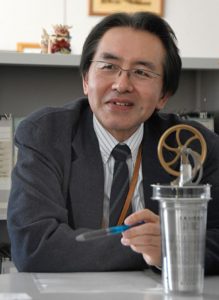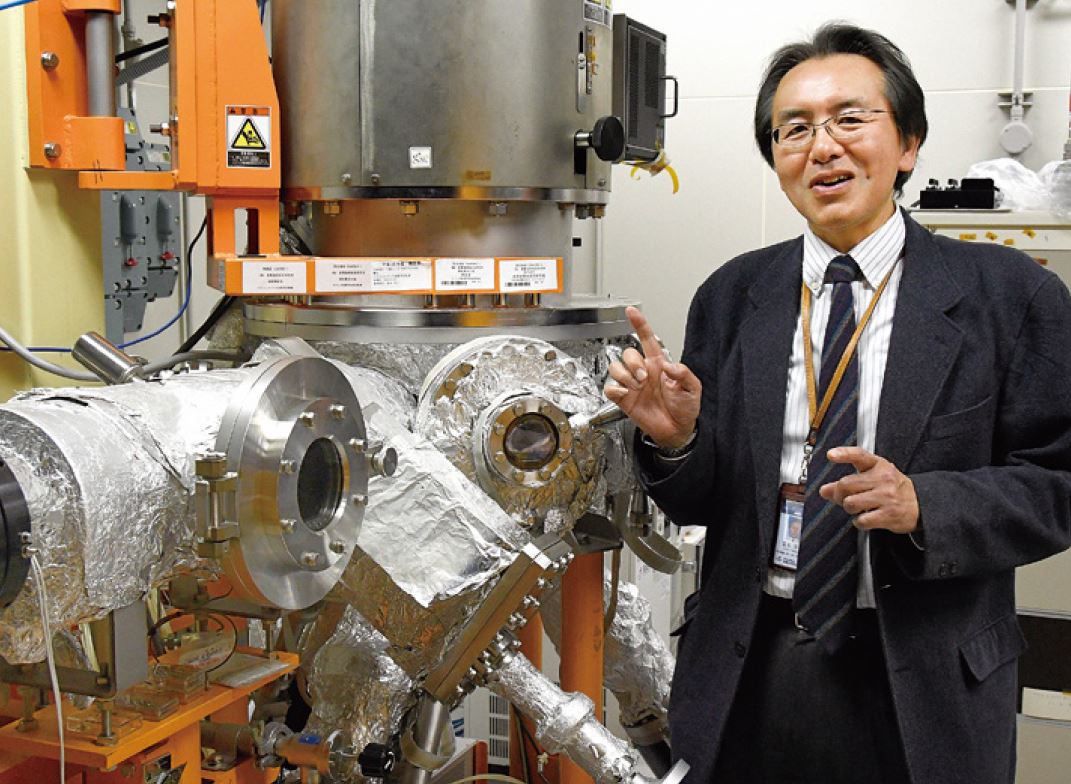This post is also available in: Japanese
Changed by a chance meeting with Prof. Tonegawa in an airport
――How did you come to join a specialized research institute?
Prior to commercialization of phasechange discs, I was told by my company to go to the U.S. to present our research results and introduce our new product. After finishing business in Boston, I was waiting for my flight to New York, my next destination. Prof. Tonegawa happened to be sitting in the seat in front of me in the departure lounge. Since he had just received the Nobel Prize and I was a fan, I decided to ask for his autograph.There was still about an hour before our flight, so I had time to chat with this senior researcher.
Prof. Tonegawa said, “So you’ve been doing research at a private corporation. It might be time for you to consider going higher.” After returning to Japan, I happened to notice in an academic journal that the National Institute for Advanced Interdisciplinary Research (present-day National Institute of Advanced Industrial Science and Technology (AIST)) was accepting applications for research positions. I sent in my application, thinking that I wanted to pursue phase-change technology all the way. Since the new product that was the result of my research had just been completed, it was a good time for me to take on another challenge.
That comment by Prof. Tonegawa in the Boston airport served as the impetus for me to take on new challenges for 22 years after joining AIST in 1997.
Development of ultra-high density optical recording disc using a GST ternary alloy

The lower part, which is equivalent to an electrode, is a cup into which hot water is to be poured. Pouring hot water into the cup is the same as applying an electrical current. This switches the phase-change film. Think of the piston as a Ge atom. It is going up and down now, isn’t it? This movement of the atom is applying work to the outside. In other words, entropy is being discarded. This is the same principle as that used for switching in phase-change memory. The author of the technical paper had thought about merely adding heat. He missed the point. The upper area is at room temperature and the heat difference from the bottom vessel causes the movement. The upper area can be used for dissipating heat.
――We understand that after you joined the Institute, you produced one new result after another.
I was one of two researchers hired through the application process. There was a third researcher who had come from the former Electrotechnical Laboratory. So with a secretary, there were four of us. We were given a newly- built research wing. Over the next 6 to 7 years, we filled the wing with equipment and people. Research back then was focused on ultra-high density optical recording using phase change. Since light is also a wave in terms of characteristics, it is not possible to focus all of it onto a single point.
Also, since waves are subject to a principle called diffraction limit, only 1/4 to 1/3 of the wavelength can be focused. So we began researching a super-resolution technology that would use a solid film and open a light window in response to heat instead of light. We used a ternary alloy consisting of antimony (Sb), germanium (Ge), and tellurium (Te). This was in 1999. For this research, we received the Minister Award from the Ministry of International Trade and Industry (present-day Ministry of Economy, Trade and Industry), and we also received an award from IBM in 2000.
Next, in 2009, we developed a Bluray DVD disc with 4X density using optical super-resolution technology. We gave a demonstration of this disc at the Kyoto Office of Mitsubishi Electric Corporation. We set up four high-definition TVs and the ultra-resolution DVD disc we had developed, along with a single Blu-ray light source, and we succeeded in projecting four images simultaneously on the four TVs.
The wavelength was 400 nanometers and the resolution was 60 to 80 nanometers. Since the current Blu-ray resolution is 140 nanometers, we were successful in projecting images with four times the current density simultaneously on four channels. The images we used included scenes of famous places in Kyoto and flowers. I think this 60-nanometer resolution might still be the world’s highest among super-resolution technologies.
Incidentally, the Nobel Prize in Chemistry 2014 was awarded for an application of super-resolution technology. It was achieved by research groups in Germany and the U.S., but their resolution was only 90 to 100 nanometers. Our resolution was superior, but they applied the technology to the medical field. When we heard the news of the Nobel Prize award, I commented to our research staff, “We just missed it! Maybe we should have targeted a living organism.” If we had worked with a living organism, we might have won the Nobel Prize …. (Laughter)
From a high-resolution phasechange disc to superlattice energy-saving phase-change solid-state memory
――New research themes seem to be showing up one after another in phase-change memory research.
The next thing we worked on was energy- saving phase-change memory utilizing the uniquely conceived superlattice, which used chalcogenide instead of a GST ternary alloy. Until then, I had been working on optical phase-change discs. However, in 2006, someone involved in semiconductor devices came to us and asked us to focus as well on phasechange memory using electricity. That was a catalyst for me. It was very good timing. That was when all companies were beginning to withdraw from optical discs and, following the economic downturn precipitated by the bankruptcy of Lehman Brothers in the fall of 2008, companies began moving their production from Japan to overseas.
The first step I took was to read technical papers related to electrically switched phase-change memory. One paper included an extremely beautiful device temperature distribution diagram that was color-coded into 1.4 million colors using thermal analysis software based on computer simulation. Although the paper described the results when the maximum temperature was 650°C (molten state) and 200°C (crystallized state), it did not say anything about the instant of phase transition. I kept wondering, “Why this omission?” I thought something was wrong. Phase change means the material goes back and forth between crystallized and amorphous states, repeatedly melting and cooling. It is a heat cycle in which the state is fixed by raising and lowering the temperature. This is a thermodynamics issue. Thermodynamics is governed by basic laws*, known as the first, second, and third laws. In other words, then, the paper used only the first law for its argument. A thermodynamic cycle would not work with just that. The paper did not consider how much entropy was being lost within the cycle. That is, it ignored the second law of thermodynamics. Since I specialized in physical chemistry, I was convinced that solving this issue would produce improved results. I thought, I would do it if nobody else was going to do it. I had also been aware of this entropy issue during the time I had previously worked on optical discs. When I made the actual calculations, I found that 95% of the energy disappeared as entropy, and I knew I had to prevent it from disappearing.
Although I could not completely eliminate entropy, my efforts to eliminate this 95% energy loss brought me to superlattice phase-change memory.

